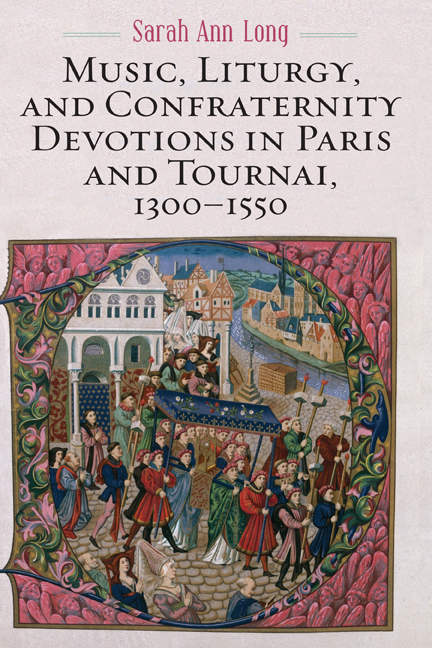Book contents
- Frontmatter
- Dedication
- Contents
- List of Illustrations
- Acknowledgments
- List of Abbreviations
- Editorial Procedures for Foreign Languages and Music Examples
- Note on Online Material
- Introduction
- 1 Confraternities and Popular Devotions to St. Barbara in Tournai
- 2 Relic Translation and Healing in Liturgies for St. Catherine and St. Nicholas in Paris
- 3 Historical Narratives and the Importance of Place in Masses for St. Sebastian
- 4 Compositional Practice, Networks, and the Dissemination of the Mass Ordinary in Confraternity Sources
- 5 The Role of the Parisian Book Production Community in the Perpetuation of Popular Devotions
- Conclusion
- Appendix 1 Sources
- Appendix 2 Inventories of Sources from Tournai
- Appendix 3 Scribal Hands and Gatherings in the Tournai Notary Confraternity Manuscripts
- Notes
- Bibliography
- Index of Chant and Polyphonic Compositions
- Index of Early Printed Liturgical Books
- Index of Manuscripts
- General Index
1 - Confraternities and Popular Devotions to St. Barbara in Tournai
Published online by Cambridge University Press: 23 June 2021
- Frontmatter
- Dedication
- Contents
- List of Illustrations
- Acknowledgments
- List of Abbreviations
- Editorial Procedures for Foreign Languages and Music Examples
- Note on Online Material
- Introduction
- 1 Confraternities and Popular Devotions to St. Barbara in Tournai
- 2 Relic Translation and Healing in Liturgies for St. Catherine and St. Nicholas in Paris
- 3 Historical Narratives and the Importance of Place in Masses for St. Sebastian
- 4 Compositional Practice, Networks, and the Dissemination of the Mass Ordinary in Confraternity Sources
- 5 The Role of the Parisian Book Production Community in the Perpetuation of Popular Devotions
- Conclusion
- Appendix 1 Sources
- Appendix 2 Inventories of Sources from Tournai
- Appendix 3 Scribal Hands and Gatherings in the Tournai Notary Confraternity Manuscripts
- Notes
- Bibliography
- Index of Chant and Polyphonic Compositions
- Index of Early Printed Liturgical Books
- Index of Manuscripts
- General Index
Summary
O beautiful violet, seedling of paradise, he has crowned you, holy Barbara, with the eminent double halo of virgin and martyr: make us to be rendered worthy of the laurel of heaven.
This antiphon text is one of many examples of intercessory prayers found in popular devotions meant to establish a direct connection between saint and supplicant. It appears as part of the Office for St. Barbara in Tournai, Archives et Bibliothèque de la Cathédrale MS A 12 (B-Tc A 12), a chant manuscript with additions from the thirteenth through sixteenth centuries used by the Confraternity of the Notaries at the Cathedral of Notre Dame in Tournai. Many of the chants for the Mass and Office in liturgical books used by confraternities are in first person narrative and end with the formula “Ora pro nobis,” or “pray for us,” and indeed, this text asks the saint to “make us to be rendered worthy of the laurel of heaven.” In addition to laudatory texts like the one above, devotional literature (Books of Hours, Miracles of the Virgin, the Golden Legend) and the liturgies that developed from it encouraged the laity to identify with the suffering of the saints by focusing on the details of their martyrdom. Music, text, and image all worked together to engage the “emotional imagination,” creating a personal experience of the saint's pain and salvation. New liturgical texts and music created for confraternities in the fourteenth through sixteenth centuries were integral to this process.
In this chapter, I explore the material culture of the Confraternity of the Notaries at the Tournai cathedral—in particular, three manuscripts they owned—and what it can tell us about the development of liturgical practices in private devotional communities at this institution. In the absence of any archival documents recording the everyday acts of the confraternity (how they interacted with the diocese, payment of musicians, and all other sundry activities), these manuscripts are the only existing sources reflecting their rituals and place within the cathedral. Since the discovery of these books in the nineteenth century, scholars have investigated isolated parts of their contents but have not sought to view each one as a whole.
- Type
- Chapter
- Information
- Publisher: Boydell & BrewerPrint publication year: 2021



